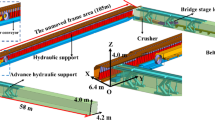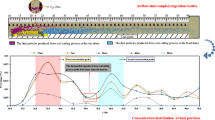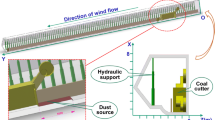Abstract
In open-pit coal mines where burned rock occurs, because the burned rock is fragile and contains a large number of fine particles, a large amount of dust will be produced in the process of mining and loading. The dust concentration is as high as 2500mg/m3 on average, which seriously affects the health of the workers in the open-pit mine and the atmospheric environment in the mining area. In order to control the dust disaster in mining and loading face with burning rock, the dust diffusion concentration model of gas-solid two-phase flow was established to study the dust escaping law. Based on the engineering background of an open-pit coal mine in Xinjiang, China, the dust concentration, dispersion, composition, and other basic parameters were tested in situ. The measured data are applied to the numerical simulation of dust diffusion. The results show that there is a negative correlation between dust surface tension coefficient and dust diffusion degree. When the dust collides, polymerizes, and breaks, the dust with high surface tension is not easy to polymerize into large particles, and the dust diffusion phenomenon is more obvious. Based on the characteristics of dust in burned rock, wet dust removal method was adopted to control dust disaster. Based on the characteristics of poor hydrophilicity of burned rock dust, in order to enhance the effect of wet dust removal, a compound dust suppressor suitable for dust removal and dust reduction in burned area was developed. The effect of the dust suppressor was verified by scanning electron microscope (SEM) test system. The results show that the dust suppressant can effectively reduce the surface tension coefficient of dust, increase the viscosity coefficient and surface tension, and make the dust easy to aggregate into large particles and settle, and the dust removal effect is good.












Similar content being viewed by others
Change history
28 September 2021
An Editorial Expression of Concern to this paper has been published: https://doi.org/10.1007/s12517-021-08472-7
References
Chen X, Ge SC, Deng CB, Zhang XH, Wang SY (2017) Research on influence of speed of dump truck on dust diffusion in open-pit mine. China Saf Sci J 27(4):151–156. https://doi.org/10.16265/j.cnki.issn.1003-3033.2017.04.027
Dong JW (2017) Dust pollution and its control in open pit mining. Inn Mong Coal Econ 24:8–9. https://doi.org/10.3969/j.issn.1008-0155.2017.24.004
Du CF, Li L (2013) Development and characterization of formulation of dust-suppressant used for stope road in open-pit mines. J Coal Sci Eng (China) 19(2):219–225. https://doi.org/10.1007/s12404-013-0217-1
GB-MT79-1984 (1984) Methods for determination of dust concentration and dispersion.China:Ministry of Coal Industry
Geng M (2018) Numerical simulation of dust concentration variation in conveyor belt roadway based on COMSOL. Light Ind Sci Technol 34(9):92–93,131
Gong Z (2016) Dust pollution and its control in open pit mining. Quotations Eng Technol 4:308–308
Jia L, Wang DX, Yu CW, Liang B (2018) Research of dust transport rule of large difference chute based on FLUENT. In: 2018 International Conference on Energy Development and Environmental Protection (EDEP 2018). Atlantis Press. https://doi.org/10.2991/edep-18.2018.33
Jin LZ (2020) Current situation and countermeasures of dust occupational hazards in China's workplace. Security 9(1):1–6
Li DH (2017) Prevention and control of mine dust and pneumoconiosis. Constr Eng Technol Des 7:2590
Li DW, Sui JJ, Liu GQ, Zhao Z (2019) Current status and development direction of coal mine dust hazard control technology in China. Min Saf Environ Prot 46(6):1–7+13
Ma Y, Zhou G, Ding J, Li S, Wang G (2018) Preparation and characterization of an agglomeration-cementing agent for dust suppression in open pit coal mining. Cellulose 25(7):4011–4029. https://doi.org/10.1007/s10570-018-1826-z
Mao Y (2018) Study on dust control technology of large open pit mine. Geomatics Min Surv 1(4). https://doi.org/10.32629/gmsm.v1i4.52
Ruan WG, Mo ZZ, Zhang P, Li YC (2016) Analysis of dust generation and pollution control measures in opencast mining process. Environ Sci Manag 41(6):96–99. https://doi.org/10.3969/j.issn.1673-1212.2016.06.022
Tang WJ (2014) Simulation study on dust distribution and migration law of stripping face in open pit mine. J China Univ Min Technol. (cnki.net)
Tang WJ (2018) Research on dust distribution and migration mechanism of open pit coal mine. J China Univ Min Technol
Tang WJ, Cai QX (2017) Analysis of dust accumulation mechanism and influencing factors in open pit mine. Min Saf Environ Prot 44(4):95–98. https://doi.org/10.3969/j.issn.1008-4495.2017.04.022
Tang WJ, Cai QX (2018) Dust distribution in open-pit mines based on monitoring data and fluent simulation. Environ Monit Assess 190(11):632. https://doi.org/10.1007/s10661-018-7004-9
Wang BY (2016) Dust removal measures in Har Wusu open-pit coal mine. Open Pit Min Technol 31(1):78–80 83
Wang Y (2018) Current status and development trends of coal mine dust control technology in China. Sci Technol 6:155–156
Xiu Z, Nie W, Yan J, Chen D, Cai P, Liu Q, Du T, Yang B (2020) Numerical simulation study on dust pollution characteristics and optimal dust control air flow rates during coal mine production. J Clean Prod 248:119197. https://doi.org/10.1016/j.jclepro.2019.119197
Zhang F (2012) Introduction to the large open-air mine dust measures, China blasting III new technology. Chinese Society of Mechanics; China Engineering Blasting Association
Zhang Q (2019) Study on dust removal mode in undisturbed area of Haerwusu open-pit coal mine. J China Univ Min Technol
Acknowledgements
Integrated technology of ecological environment restoration and mining in open-pit coal mine based on green degree, Project Grant No. 51474119, National Natural Science Foundation of China, is acknowledged.
Author information
Authors and Affiliations
Corresponding author
Ethics declarations
Conflict of interest
The authors declare that they have no competing interests.
Additional information
Responsible Editor: Ahmed Farouk
This article is part of the Topical Collection on Big Data and Intelligent Computing Techniques in Geosciences
Rights and permissions
About this article
Cite this article
Jia, Z., Song, Z., Zhao, X. et al. Dust transport law and dust suppression technology based on gas-solid two-phase flow. Arab J Geosci 14, 1751 (2021). https://doi.org/10.1007/s12517-021-08121-z
Received:
Accepted:
Published:
DOI: https://doi.org/10.1007/s12517-021-08121-z




